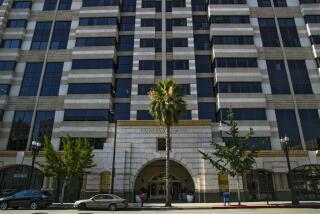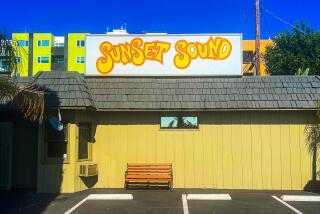One Egg, One Basket : Photo Acoustic Dreams of Soaring Beyond Sole Product, But Lack of Money Clips Wings
- Share via
Photo Acoustic Technology counts Morton Thiokol, the National Aeronautics and Space Administration, and Control Data among its customers.
Many of Photo Acoustic’s clients rely on its product--an ultraviolet sensor that detects contamination--to guarantee that surfaces are clean enough to be bonded together. The ultraviolet sensors detect dirt as slight as one-twentieth the thickness of a fingerprint.
Photo Acoustic’s biggest customer is Morton Thiokol, which uses the sensors to scan the inside surfaces of the space shuttle’s rocket boosters to make sure any loose contaminant doesn’t cause them to come unglued in flight.
It’s a pretty heavy responsibility for a company started only five years ago by two former aerospace executives with $40,000 of their savings. Nowadays, Photo Acoustic, based in Westlake Village, can even boast a profit, albeit very small. For the year that ended Jan. 31, the company made $103,557, on revenue of $1 million.
For all the firm has done for space travel, Wall Street investment bankers aren’t exactly seeing stars. The biggest problem is that the company makes only one product, and it has a limited market. Photo Acoustic, for example, has no cushy long-term contract with NASA or Morton Thiokol to provide its ultraviolet sensors. Instead, NASA and Morton Thiokol buy the sensors piecemeal for between $45,000 and $50,000 each. So Photo Acoustic’s tiny size and the limited market for its product make it an unappealing company for brokerages to tout and trade the stock.
The company’s management has had to go door-to-door to find brokerage houses to help it raise money for the research and development it needs to come up with new products.
“It’s difficult being a small company to find a good investment banker to work with us,” complained Mantosh Chawla, Photo Acoustic’s co-founder and president. “It’s like going to a bank for a loan. If you can get it, you don’t need it. If you need it, they won’t give it to you.”
Many of the company’s ideas have sat idly on the drawing board because of a lack of funds. Even its sound-wave sensor--which accounts for part of the company’s name--has never been completed.
Another new product idea is a robot-vision system--the RV4000--which uses sound waves to guide itself along surfaces. The companys says the robot can perform all kinds of jobs, including painting a car.
Photo Acoustic has been burned several times after it has gone with inexperienced and unknown brokerages willing to take a gamble.
The latest stumble centers on a plan by Photo Acoustic’s board to raise at least $1 million from warrant-holders.
“The purpose of raising the money was to allow us to do some additional research, maybe add one or two products so that we are less dependent on one technology, one product,” said Chawla, 41.
Unfortunately, the company has raised only about $150,000, even though the so-called “exercise price”--what warrant-holders pay to exchange their warrant for a share of common stock--was lowered by the board from $3 to $1.75 to encourage buying.
The lower exercise price was intended as a limited-time offer. Photo Acoustic’s board told warrant-holders they had until the end of June to buy in at $1.75. The offer was a good one because the stock was trading on the Philadelphia Stock Exchange at above $2, so shareholders automatically made a paper profit when they exercised their warrants. Sometimes they made more than 50 cents a share.
But only a fraction of the warrants were converted before Photo Acoustic’s stock took a dive in mid-May, and by then there was little incentive for any shareholders to exercise their warrants.
The company has since extended its offer to Oct. 31 for warrant-holders. And the company’s stock has recovered somewhat. It closed Friday at $2 a share.
But clearly Photo Acoustic’s fund raising hasn’t gone as smoothly as it hoped. What happened? Last month, the New York broker-
age house that was the company’s major market-maker--that is, it handled close to 90% of all the buy and sell orders for Photo Acoustic stock--collapsed and shareholders panicked, fearing that no other brokerage would be willing to handle transactions.
Shareholders started dumping their stock on the open market on May 13, after Steven Andrew & Co. announced it had been shut down by the National Assn. of Securities Dealers. Photo Acoustic’s stock plummeted from $2 to 75 cents a share.
Steven Andrew & Co. President John Figliolini said his firm failed to keep a minimum balance of $30,000, which NASD requires of all members. NASD fined Steven Andrew $15,000, which forced it to close.
Since then, Photo Acoustic’s other market-makers have continued to trade the stock, but the stock’s stumble has dashed--at least temporarily--the company’s hopes of raising the research and development money that it dearly needs to diversify.
Chawla--a former Hughes Aircraft executive--started Photo Acoustic in 1983 with his brother-in-law, Arvin Aurora, a former project manager at Rockwell International. The two had been friends for 25 years and dreamed of starting their own business. Aurora left the company in 1986 after he and Chawla had a falling out during Aurora’s divorce. The two haven’t spoken in over a year.
The company sputtered its first couple of years, before Control Data bought 30 sensors at an average price of $25,000 each. Control Data is still a major customer and uses the sensors to measure the amount of lubricant placed on their computer hard disks. Control Data accounted for 50% of Photo Acoustic’s sales in fiscal 1987.
Photo Acoustic has also done well with other big customers: In fiscal 1988, NASA accounts for 38% of Photo Acoustic’s sales; Morton Thiokol, 15%.
Photo Acoustic sensors scan the inside of the rocket booster to make sure no grease is remaining. “The casing of the solid rocket booster is made out of steel,” explained Chawla. “When it is machined, they dip it into a grease to protect it from rusting. When they’re ready to do the next step, which is to bond a rubber lining to the inside of that casing, they have to clean all of that grease off.”
Raymond Gause, NASA’s chief of engineering at the Marshall Space Flight Center in Alabama, said Photo Acoustic equipment has improved the strength of the bonds on the shuttle because it has found grease which would have gone undetected.
Seeking Investors
But with no long-term contracts to rely on, as a cushion, Photo Acoustics has tried to drum up money from investors. Mostly, this has led to problems. The New York brokerage of Citiwide Securities took the company public in 1985. The brokerage promised it could raise $2.5 million; instead, it raised less than half of that.
Citiwide was one of many so-called “penny stock” brokerages that try to raise money for inexperienced companies with good ideas. “Going through the penny stock underwriters isn’t worth it,” said Aurora. “But when you’re desperate for money, there appears no other way out.”
Citiwide soon went bankrupt, and its president was indicted for fraud, grand larceny and tax evasion.
Still needing money, Photo Acoustic turned to Figliolini, a former Citiwide executive who had started Steven Andrew & Co. as his own brokerage. Figliolini was planning on helping Photo Acoustic persuade shareholders to exercise their warrants.
So Photo Acoustics is back to where it started--a tiny company with a respected product, good ideas and virtually no money to develop them.
Showing around a visitor, Chawla was asked about the company’s RV4000 robot, which got a design award in 1985 from Research and Development magazine. He walked into a utility room, saying: “We haven’t done much work on that for a while, so it’s probably sitting in a box.”
More to Read
Inside the business of entertainment
The Wide Shot brings you news, analysis and insights on everything from streaming wars to production — and what it all means for the future.
You may occasionally receive promotional content from the Los Angeles Times.










